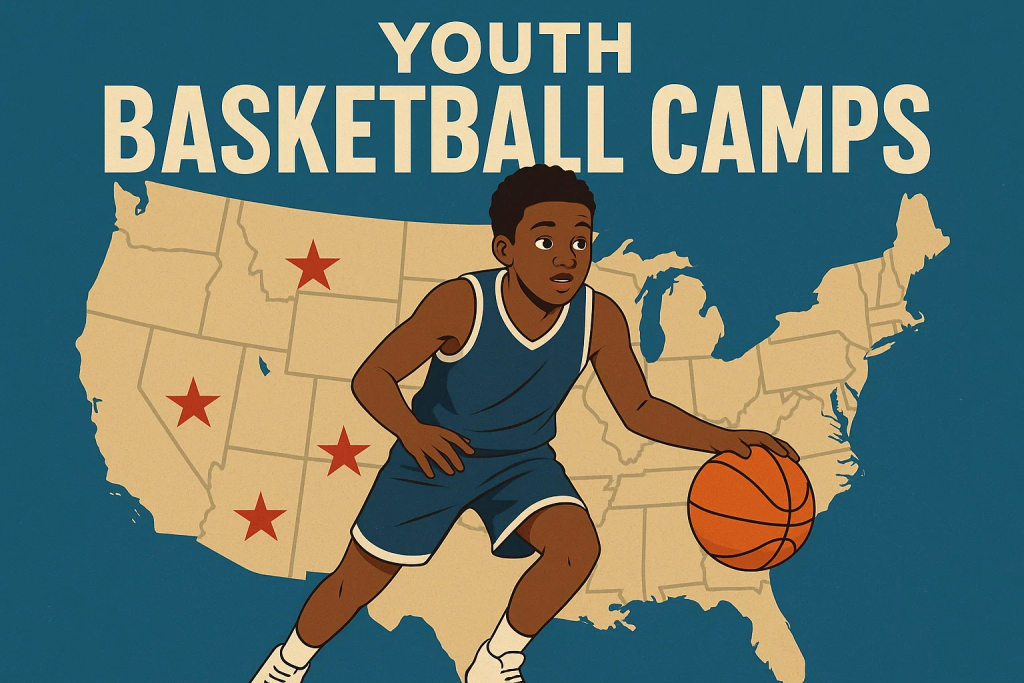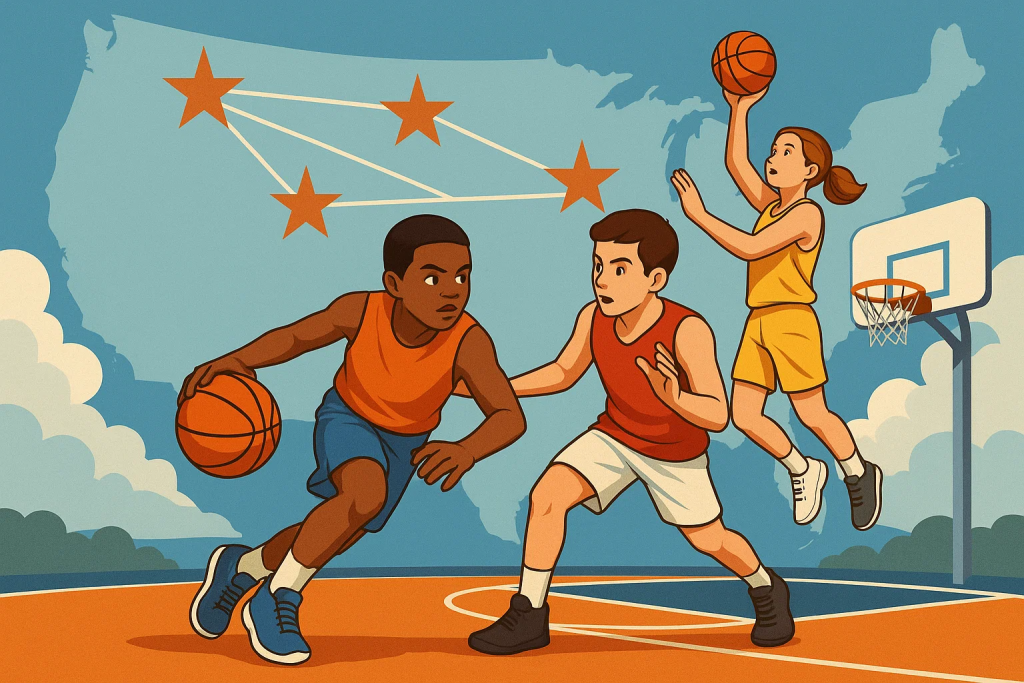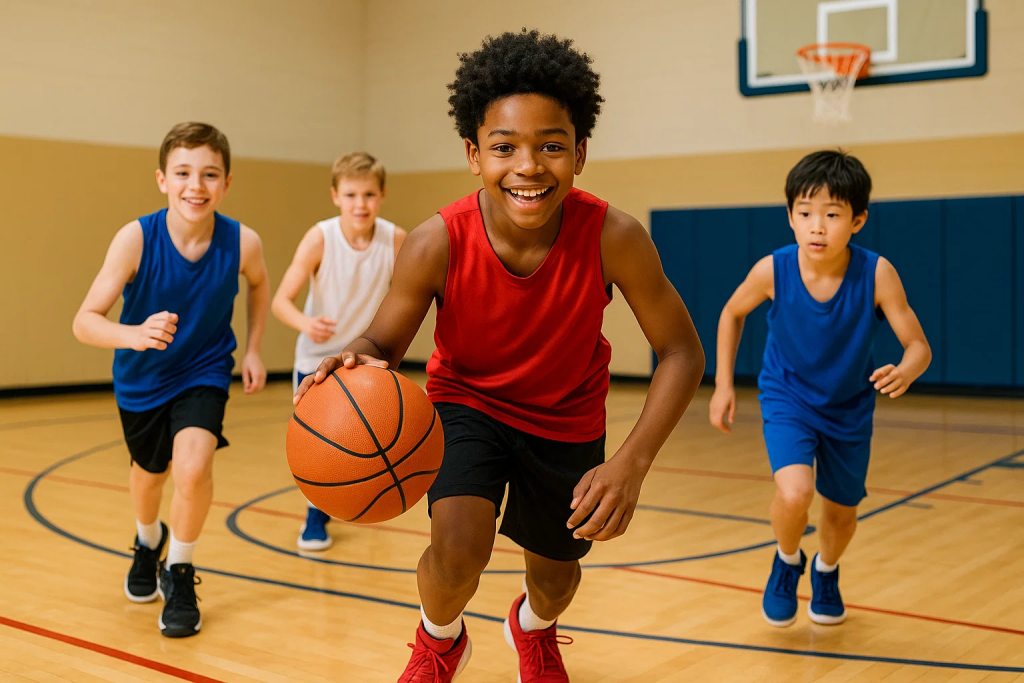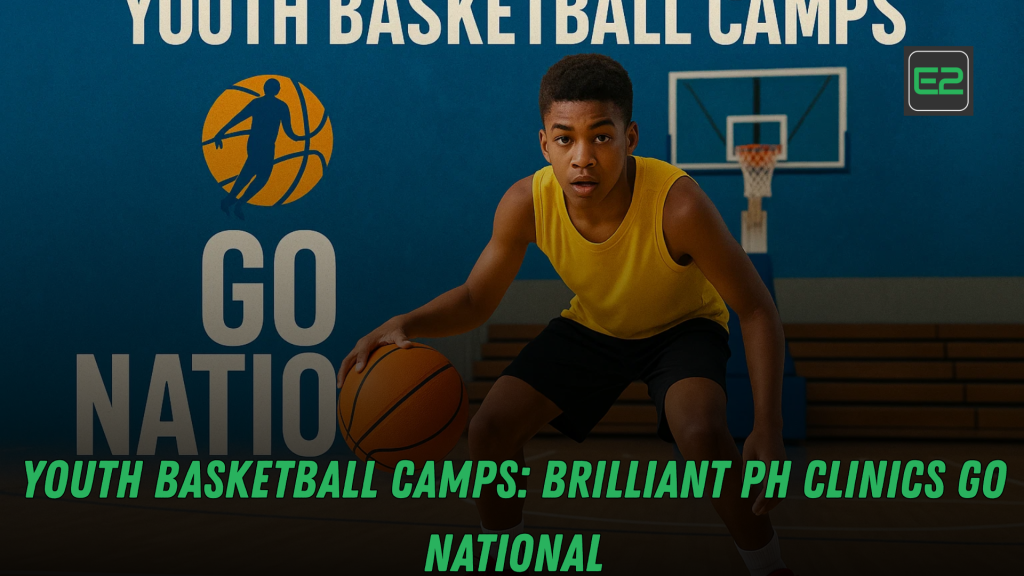Table of Contents
Youth basketball camps have moved from occasional summer clinics to a year-round, national movement—equal parts classroom, gym, playground, and character lab. The Philippines has always been a hoops country, but the post-pandemic surge in play has sharpened attention on what really builds better players: consistent reps, safe coaching, and a clear pathway. This long-form guide maps how to launch, scale, and sustain a camp system that matches Filipino realities—heat, travel, school calendars, tight budgets—while delivering measurable improvement that families, schools, LGUs, and sponsors can believe in.

Executive Snapshot: why scale now, and how to do it right
A new generation of parents wants structured activity, not just open play. Coaches are hungry for modern tools. Brands and LGUs prioritize health, education, and community impact. The moment is perfect for programs that teach fundamentals, protect bodies, and celebrate small wins on the road to big ones. Done well, youth basketball camps become a reliable operating system for development: a shared curriculum, a national coach pathway, simple data dashboards, and community storytelling that keeps the court full and the dream alive.
Camps as an Operating System, not a one-off event
Treat your program like software. Version it. Test it. Update it. At its best, a camp is a daily rhythm: check-in, warm-up, skill block, constrained games, recovery, reflection. The system syncs people (athletes, coaches, parents), processes (safety, curriculum, feedback), and platforms (facilities, scheduling apps, media). When those elements click, sessions feel smooth and results compound. When they don’t, you get burnout, nagging injuries, and highlight hunting without habits. Build your OS once, then roll it out city by city, so youth basketball camps feel the same quality everywhere.
What “National-Grade” actually means
National-grade is not about a big logo. It’s a promise delivered locally:
- Identity: One sentence that defines your promise (“Safer skills, smarter reads, stronger kids”).
- Standards: Age-graded goals, coach-to-player ratios, heat policies, hydration rules, and emergency drills.
- Coach Pathway: Badges, mentorship, and refreshers so a session in Davao feels like a session in QC.
- Measurement: Two-minute dashboards parents and sponsors can understand.
- Inclusion: Scholarships, girls’ windows, adaptive sessions, language-aware coaching.
- Storytelling: Progress posts and community days that invite newcomers to try.
Build these six pillars and you’ll have youth basketball camps that scale without losing soul.
The Curriculum That Sticks (and grows with the athlete)
Design for Filipino courts and constraints—tropical heat, limited indoor time, mixed experience levels. A modular curriculum with three levels (Foundation, Development, Performance) keeps everyone moving.
Core blocks
- Footwork & Balance: stance, drops, pivots, closeouts, landing.
- Handle & Decision: pace control, eyes up, read-and-react under constraints.
- Finishing & Contact: angles, off-foot layups, floaters, two-foot power.
- Shooting System: base → sequencing → arc; frequent short makes, not marathons.
- Defense & Disruption: stance–slides–angles, stunt-and-recover, verticality.
- Transition & Spacing: first three steps, lanes, drag screens, advantage protection.
- Strength–Mobility: ankle/knee/hip prep, core, shoulder health.
- Game IQ & Mindset: time/score, breath control, cue words, huddle roles.
This spine lets youth basketball camps adapt to age, skill, and venue while pushing consistent standards.
Age Bands and What They Need Most
- U8–U10 (Discover): 60–75 minutes. 70% games, 30% skills. Focus on balance, ball-in-hand time, and fun.
- U11–U13 (Build): 90 minutes. 50/50 skills and small-sided games; introduce decisions and weak-hand reps.
- U14–U16 (Compete): 120 minutes. 60% skills, 40% constrained scrimmage; load management matters.
- U17–U19 (Perform): 120–150 minutes. Role clarity, film literacy, basic lifts, recovery education.
Small-sided play (2v2, 3v3, 4v4) squeezes maximum touches into limited space—exactly what youth basketball camps need to create rapid learning.
A Model Day (U14–U16, 120 minutes)
Check-in (5’): Sleep/hydration RPE; quick ankle/hip screen.
Warm-up (10’): Hop-stick, lateral bounds, breath primer.
Skill Block 1 (20’): Drops → cross-step → push-cross with visual triggers.
Skill Block 2 (20’): Form to range ladder; 45 makes split by distance.
Games (25’): 3v3 advantage starts; “no dribble first pass” rule; points on stops.
Defense (15’): Closeout angles, stunt-and-recover; charge safety and verticality.
Conditioning (10’): Court shuttles with heart-rate caps, decel technique.
Cooldown (10’): Breath ladder; two-wins-one-repeat journaling; hydration.
Replicate this spine and your youth basketball camps will feel professional without expensive gear.
Safety First: heat, hydration, landing, and red flags
- Heat index tiers: shade/water every 12–15 minutes at “moderate,” switch indoor or reduce load at “high.”
- Hydration math: 3–7 ml/kg in the 2–4 hours pre-session; sip 150–250 ml every 15–20 minutes.
- Landing & cutting: teach decel (hips back, nose over toes), two-step stops, outside-foot cuts.
- Red flags: knee collapse, persistent shin pain, shoulder pinch—adjust drills or rest immediately.
Families judge trust by care before highlights. Safe kids stay, and safe kids improve—core truths for youth basketball camps everywhere.
Data Without the Drama: a two-minute dashboard
Keep measurement simple and actionable:
- Technical: make % (form, mid, off-move); weak-hand control; turnovers in 3v3.
- Physical: hop-test symmetry; plank time; shuttle split consistency.
- Game IQ: decision success in constraints; spacing errors; talk metrics.
- Wellness: attendance; sleep self-report; soreness zones.
Color-code improvements; celebrate deltas, not just raw numbers. When parents can see progress, youth basketball camps gain loyalty and word-of-mouth growth.
Coaching the Coaches: scale people, not just dates
A national program rises or falls on coach quality. Build a pathway:
- Level 1 (Foundation): safety rituals, demonstrations, cue words, flow management.
- Level 2 (Development): constraints-led design, feedback timing, mixed-level leveling.
- Level 3 (Performance): film study, scouting basics, load management, return-to-play.
Pair each badge with a mentor circle (one veteran to five juniors) and quarterly refreshers. Shared drill libraries and film snippets keep youth basketball camps aligned from city to city.
Parents as Performance Partners
Parents are the engine of consistency. Give them a playbook:
- Sideline code: cheer effort, not outcomes; no tactical coaching mid-drill.
- Home pack: 10-minute form shooting, 10-minute mobility, ball-handling ladder.
- Food & Fluid: pre-session carbs + protein; post-session protein 20–25 g + water.
When moms and dads understand the plan, youth basketball camps become a partnership rather than a purchase.
Girls’ Game, Big Future
Unlock half the talent with design, not slogans:
- Girls-only windows in Discover and Build bands to reduce intimidation.
- Female coach visibility as leads and demonstrators.
- Role models: collegiate or national players for Q&A.
- ACL-aware prep: landing mechanics and hip-knee control in warm-ups.
Normalize, don’t “other.” When girls feel seen and safe, youth basketball camps double their impact.
Accessibility and Affordability: remove the real barriers
- Tiered pricing: full, partial, scholarship; publish criteria.
- Group discounts: schools, barangays, siblings.
- Gear library: loaner balls, reversible jerseys, ankle braces.
- Transport pooling: parent rotations; partner trikes/jeeps on fixed schedules.
If price is the only barrier, your design failed. Accessible youth basketball camps expand the funnel and the future fanbase.

Venues and Logistics: the hub-and-spoke model
- Hubs: regional centers with indoor courts, shade sails, med access.
- Spokes: barangay gyms, school courts, pop-up floors with canopies.
- Calendar: 10-month presence, with breaks for exam weeks and major holidays.
- Local partners: LGUs, schools, civic groups—booked months ahead; clear MOU.
Consistency of infrastructure is why top youth basketball camps feel reliable even in small towns.
Media & Community: make learning visible
- Learning-first content: daily “What we learned” clips (30–60 seconds).
- Milestone boards: team make-percentage improvements, not just “MVP.”
- Community days: free open courts, girls’ tryouts, parents vs. coaches scrimmages.
Storytelling brings in the curious and honors the committed. That’s how youth basketball camps sustain energy between cohorts.
Sample 6-Week Plan (with weekly themes)
Week 1 – Baselines & Balance: stance, stops, starts, form shooting, 2v2 spacing starter.
Week 2 – Handle Under Pressure: drops, push-cross, weak-hand finishes, stunt-and-close.
Week 3 – Shoot on the Move: stop-in-two pull-ups, catch-on-the-hop, peel switches.
Week 4 – Craft at the Rim: angles, floaters, delay screens, shell defense with tags.
Week 5 – Second-Side Decisions: paint touch → kick → extra, inbound IQ, breath under fatigue.
Week 6 – Performance Week: mini combine, film snippets, parent huddle, next-step plan.
Simple, progressive, repeatable—exactly what youth basketball camps need to maintain quality across sites.
The 90-Day Launch Blueprint (City Playbook)
Days 1–15 (Foundation): secure two venues; recruit lead coaches; publish standards; open scholarships; set heat/hydration policy.
Days 16–45 (Pilot): run two cohorts; capture metrics; fix flow; host a girls-only Saturday; publish first “learning” clips.
Days 46–75 (Scale): add a second site; train assistants; negotiate transport and snacks; start gear library.
Days 76–90 (Lock): finalize calendar; announce a mini-league; publish an impact brief with attendance, scholarship counts, injury-free rates, and improvement charts.
With documentation, the second city launches in half the time—how youth basketball camps multiply without losing quality.
Sponsorship and Sustainability: value that brands can see
- Why brands care: health impact, educational outcomes, family engagement, positive media.
- Assets: jersey panels, skill-station naming, “learning of the day” posts, community days.
- Reports: attendance, scholarships awarded, injury-free rates, make-percentage lifts, parent satisfaction.
Transparent reporting turns goodwill into long-term support—and keeps youth basketball camps affordable for more families.
Mistakes to Avoid (and easy fixes)
- Overloading sessions to impress—quality beats volume; cap reps and mind heat.
- Teaching systems before skills—foundation first, then schemes.
- Ignoring girls’ access—schedule windows, show women coaches.
- No measurement—then no proof; adopt the two-minute dashboard.
- Pushing through pain—choose longevity; “walk away healthy” is a win.
- Highlight hunting—reward repeatable behaviors; applause for “extra pass” and “good closeout.”
Clean up these errors and your youth basketball camps will feel smarter, safer, and more fun.
Composite Case Study: a provincial hub that scaled
A provincial city piloted two courts, 80 kids, and a coach ratio of 1:10. Standards included heat-index pauses and a laminated dashboard per athlete. After six weeks, average form-shooting make rate rose 16 points, shuttle split variance dropped 22%, and soreness reports halved. Parents loved the daily learning posts; the LGU added shade sails; a clinic donated ankle braces. Within a quarter, the program opened two more towns. The lesson: with safety, measurement, and joy leading, youth basketball camps scale organically and credibly.
The Human Side: energy, emotion, and buy-in
Stats matter, but people win. Track sleep, soreness, and mood; let captains run micro-huddles that set one “do more” and one “do less” for the day. Teach breath ladders (inhale 4, hold 2, exhale 6, hold 2) and cue words (“soft eyes,” “strong base”). Celebrate small, boring habits—water breaks, knee-friendly landings—as foundational wins. This is the culture work that makes youth basketball camps feel safe, steady, and sticky.
Travel and Tournament Readiness
As cohorts progress, introduce game-day routines: pack lists, arrival timelines, walk-the-court habits, and a calm-down menu (long exhale, shoulder roll, neutral thought, sip of water). Add a “green talk” code—one verb + one noun (“Close middle,” “Protect glass”). When kids know exactly what to do under noise and fatigue, your graduates look composed beyond their years—another reason parents trust youth basketball camps as the right on-ramp.
Return-to-Play: the rehab mindset for teens
Injuries happen. Create a clear path back: medical clearance, range-of-motion checks, graded exposures (straight-line jog → cuts → contact), and confidence reps that feel easy before they feel heroic. Coordinate therapist notes with coach plans so the athlete hears one message. Emphasize sleep, protein, and patience. Teen bodies rebound fast when stress is managed—proof that wise youth basketball camps protect today’s session without sacrificing next month’s season.
Leadership Pipeline: captains, counselors, and young coaches
Invite high schoolers to assist in younger bands. Teach whistle etiquette, demo quality, and kindness. Pay stipends when possible. This creates role models on court and a bench of future instructors off it. Alumni who coach or counsel keep history and standards alive. That mentorship flywheel is how youth basketball camps become a community institution, not a seasonal product.

Content that Educates (and wins hearts)
Shift the feed from pure hype to teachable moments: “3 ways to land safer,” “How to breathe before free throws,” “What we learned in 3v3 today.” Feature parents explaining why the schedule works, girls describing their first week, and coaches sharing one drill kids loved. When content answers questions families actually ask, youth basketball camps attract the curious and retain the committed.
Environmental Realities: outdoor courts done right
Most towns depend on outdoor floors. Embrace it with smart design: shade sails, misting fans, water stations, and court-side recovery mats. Paint clear lanes and teaching marks; add a small med table with ankle tape and ice. Post heat-policy signs where everyone can see them. With a few upgrades, outdoor sites feel safe enough for quality work—letting youth basketball camps reach more kids without waiting for perfect buildings.
The Economics of Joy: pricing, scholarships, and value
Families value predictability. Publish dates early, offer staggered payments, and explain exactly what fees fund (coach pay, gear, med, scholarships). Spotlight donors who cover slots for first-timers. Track retention: returning families are the strongest signal you’re priced fairly. When money explains mission, youth basketball camps earn patience through rainy weeks and busy months.
Sports Psychology: Filipino Amazing Prep for the Key Mental Game
Call to Action: join, host, coach, or sponsor
If you’re an athlete, register for the nearest cohort and invite a classmate who’s never tried organized play. If you’re a parent, block two mornings a week to observe and learn the home pack. If you’re a coach, start your badge path and mentor a new instructor. If you’re an LGU or school, open your court for a pilot month and co-host a community day. If you’re a brand, fund scholarships and “learning of the day” content. Momentum happens when every stakeholder moves at once—exactly how youth basketball camps go from city pilots to a national ladder.
Frequently Asked Questions
1) What age is best to start?
Kids can begin as early as 7–8 in discovery blocks focused on coordination and fun. Older beginners fit into Build or Compete bands that scale intensity safely. Programs that respect developmental stages make youth basketball camps welcoming for first-timers and late starters alike.
2) How many sessions per week should we target?
Two to three sessions balance learning and recovery. Add a short home routine—10 minutes of form shooting and mobility—to keep gains between court days. Consistency beats intensity, which is why youth basketball camps emphasize rhythm over marathons.
3) What gear is required to join?
Court shoes, breathable clothing, a labeled water bottle, and a properly sized ball. Many operators maintain loaner libraries for first-timers and scholarship athletes so cost doesn’t block access. Removing friction is central to inclusive youth basketball camps.
4) Are girls and mixed groups accommodated?
Yes. High-quality programs run girls-only windows and mixed sessions, adjust cues, and prioritize female coach visibility. When design reduces intimidation and improves safety, youth basketball camps unlock twice the talent pool.
5) How do camps measure real progress?
Through simple dashboards: shooting percentages, shuttle split consistency, decision success in small-sided games, and wellness indicators. Parents receive quick updates and athletes see their own deltas—one reason youth basketball camps build trust and repeat participation.
